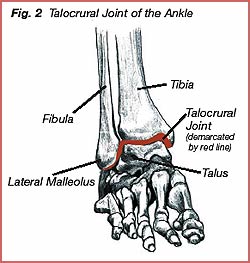Impingement sign ankle
Top Contributors - Melissa Billy, Admin, Chrysolite Jyothi Kommu, Adam Vallely Farrell, Kim Jackson, Eric Robertson, WikiSysop, Wanda van Niekerk, Evan Thomas and Vidya Acharya
Purpose[edit | edit source]
The abnormal entrapment or contact of structures resulting in pain or restricted motion is impingement[1]. This test is done for anterior impingement of the talocrural joint of the ankle. Anterior ankle impingement syndrome results from compression of structures during dorsiflexion at the anterior margin of the tibiotalar joint[1].
Clinically Relevant anatomy[edit | edit source]
The foot and ankle form a complex system that consists of 28 bones, 33 joints, 112 ligaments, controlled by 13 extrinsic and 21 intrinsic muscles. The foot is subdivided into the rearfoot, midfoot, and forefoot. It functions as a rigid structure for weight-bearing and it can also function as a flexible structure to conform to uneven terrain. The foot and ankle provide various important functions which include supporting body weight, providing balance, shock absorption, transferring ground reaction forces, compensating for proximal malalignment, and substituting hand function in individuals with upper extremity amputation/paralysis. [2][3]
The talocrural joint is formed between the distal tibia-fibula and talus and is commonly known as the ankle joint. The distal and inferior aspect of the tibia – known as the plafond – is connected to the fibula via tibiofibular ligaments forming a strong mortise that articulates with the talar dome distally. It is a hinge joint and allows for dorsiflexion and plantarflexion movements in the sagittal plane.[2]
Technique[edit | edit source]
Clinician faces the patient in a seated position. The clinician grasps the calcaneus with the hand on the lateral side of the foot with fingers around the calcaneal tuberosity and thumb over the anterolateral portion of the ankle. The medial hand grasps the forefoot. Initially, the foot is held in plantarflexion. While pressure is applied with the examining thumb, the foot is brought from a plantarflexed position to full dorsiflexion.
Positive Test: Pain reproduced from combined movement with thumb pressure and pain is greater in dorsiflexion than in plantarflexion.
Negative Test: Pain is not increased with combined movement.
Interpretation[edit | edit source]
The closed pack position of the talocrural joint is full dorsiflexion. During the ankle impingement test, the patient is brought into this closed pack position, placing several connective tissues and muscles on passive tension. Moreover, the trochlear surface of the talus is wider anteriorly than posteriorly. When the patient is brought into full dorsiflexion the concave tibiofibular segment of the ankle mortise is brought into increased contact with the talus which creates a wedging or impinging effect. [6][7]
Evidence[edit | edit source]
Minimal data is available on the clinical significance of the Impingement ankle sign. Available evidence reports;
Sensitivity: 94.8% -LR = .06
Specificity: 88% +LR = 7.9[8]
Resources[edit | edit source]
Anteromedial impingement of the ankle: using MR arthrography to assess the anteromedial recess.
Talar impingement by the anteroinferior tibiofibular ligament. A cause of chronic pain in the ankle after inversion sprain.
Anterolateral fibrous impingement of the ankle. Report of 14 cases
Anterolateral impingement of the ankle.
Diagnosis of anterolateral ankle impingement. Comparison between magnetic resonance imaging and clinical examination.
References[edit | edit source]
- ↑ 1.0 1.1 Kyle P. Lavery, Kevin J. McHale, William H. Rossy & George Theodore. Ankle Impingement.Journal of Orthopaedic Surgery and Research volume 11, Article number: 97 (2016)
- ↑ 2.0 2.1 Foot and Ankle Structure and Function. (2017, November 6). Physiopedia, . Retrieved 14:47, December 29, 2017 from https://www.physio-pedia.com/index.php?title=Foot_and_Ankle_Structure_and_Function&oldid=180503.
- ↑ Houglum PA, Bertoti DB. Brunnstrom's clinical kinesiology. FA Davis; 2012
- ↑ Malloy S, Solan MC, Bendall SP. Synovial impingement in the ankle. A new physical sign. J Bone Joint Surg Br 2003;85(3):330-333.
- ↑ The Student Physical Therapist. Ankle Impingement Sign. Available from: https://www.youtube.com/watch?v=_xlwMP7Srw8
- ↑ Flynn , Timothy. Users' Guide to Musculoskeletal Examination. USA: Evidence in Motion, 2008. Print.
- ↑ https://www.thestudentphysicaltherapist.com/impingement-sign.html
- ↑ Flynn TW, Cleland JA, Whitman JM. Users' guide to the musculoskeletal examination: fundamentals for the evidence based clinician. United States; Evidence in Motion:2008.







